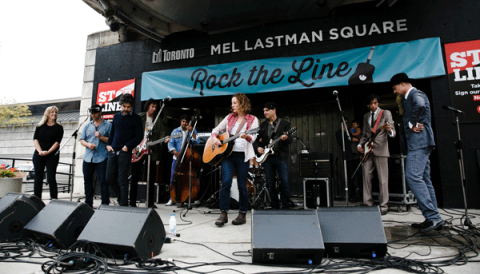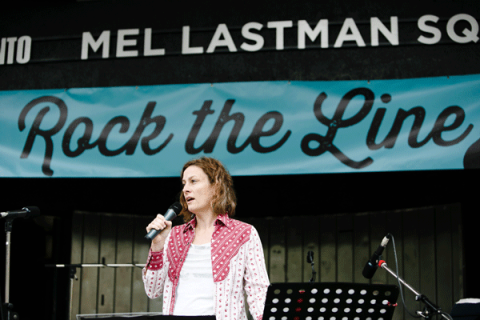
Sarah Harmer is tackling another goliath. The Ontario-born singer-songwriter who joined forces with the Environmental Defence and successfully prevented a quarry from being built, is now going up against Enbridge Inc. which operates the world’s largest crude oil and liquid pipeline system located in Canada and the United States. She will be one of the intervenors at the hearing. In November 2012, Enbridge Pipelines Inc. filed an application with the National Energy Board Act, asking to reverse the portion of Line 9 pipeline, between North Westover, Ont. and Montreal, in addition to an expansion of the line capacity from Sarnia, Ont. to Montreal and a revision of the Regulation Tariff to allow transportation of heavy crude (bitumen, tar sands, oil sands).
Harmer is currently in Montreal all week to hear Enbridge’s argument, held at Palais des congrès de Montréal. It’s in French, she says, but she’ll rely on the transcription and make plenty of notes so that she’s prepared for her oral argument back in Toronto at the Metro Toronto Convention Centre on Saturday, the 19th. “I submitted written evidence in August that I worked a long time on, so I’m not just going to reiterate that. I’m going to try to listen to them and then argue against them,” Harmer tells Samaritanmag.
Here’s why she’s so passionate about this latest fight against Enbridge’s Line 9 pipeline plan.
In layman’s terms, can you explain the repercussions of using this old Line 9 pipeline to pump a heavier crude oil?
Yeah, it’s super basic. I mean, if you like drinking clean water and having a safe place to live and a healthy environment, which is everybody’s inclination I think, you need to be really aware and alarmed at this proposal. One line goes through Ontario from Sarnia to Montreal. It’s been in the ground, about a metre or two for the last 40 years almost, since the mid-70s. It’s an oil pipeline. It was put there to transport light crude oil. Now, Enbridge — who’s the transportation company/pipeline owner — wants to reverse the flow, so instead of pumping from Montreal to Sarnia, they want to pump it from Sarnia to Montreal, and they actually want to change the substance that they put in it.
So picture peanut butter cut with carcinogenic chemicals so that it can flow through this 40-year-old pipeline. That’s what they want to pump at higher pressure and increased capacity. They’re finding hundreds and hundreds, if not thousands of areas of corrosion, dents, issues with the line. And this stuff is highly combustible, very abrasive, and it runs past 9 million or more people. Every watercourse that goes into Lake Ontario, it crosses. And so it’s an opportunity for people to be like, “Okay, here we go.” Normally who thinks about pipelines? They’re all over the place. But this one is of the very same vintage and the same kind of pipeline, only like a ¼ inch thick in Michigan, three years ago, that Enbridge owned, spilled and pumped for 17 hours, and injured people. It was still not cleaned up. It cost a billion dollars. It’s just a bad idea.
[Editor’s note: Some 300 people suffered “adverse health effects related to benzene exposure,” according to the National Transportation Safety Board. In July 2010, Enbridge Line 6B ruptured, spilling 1 million gallons of diluted bitumen for 17 hours into the Talmadge Creek in Calhoun County, which leads into the Kalamazoo River, according to the United States Environmental Protection Agency. By the summer of 2012, clean up had cost an estimated $800 million; the U.S. Department of Transportation fined Enbridge $3.7 million and outlined 22 probable violations. The National Transportation Safety Board report cited “multiple small corrosion-fatigue cracks” as the principle cause.]
So the main concern is that the Line 9 pipeline is four decades old? It’s not that Enbridge will also be reversing the flow?
I’m not a pipeline expert, but experts have said that does definitely change things as far as where the shut-off valves are, you know, technical stuff. It is an issue; it’s not a benign change.
After the Michigan spill, Enbridge implemented more stringent testing of the existing pipeline and also say that an investigation by the U.S. National Academy of Sciences, released in June, determined that the diluted bitumen is no more corrosive than other crude oil.
It’s definitely more abrasive. They did have a reviewed study on the corrosivity, but that’s definitely still up for debate, I don’t think it’s been sorted.
If these studies did turn out to be correct, would you still oppose the proposal or would you say, “Ah, okay”?
I don’t think the proposal is still worth getting behind because it’s not just whether it’s more corrosive or not. Tar sands oil has been found to be more likely to spill. Also, the bigger picture of tying ourselves into antiquated tar sands oil. Do we really want to reinforce an infrastructure that ties us into the largest carbon-producing project on the planet? We have better choices now. It’s a transition time to renewables, to transit. There’s lots happening that’s making us use less gas — fuel efficiency — there’s lots of variables. To follow up on the spill from Michigan, whether anything’s been sorted and resolved since then — the Toronto Fire Department has said that Enbridge’s safety response plan is generic; they take between 90 minutes and four hours of response time — I don’t think the assurances are comforting. It’s not, ‘Ah, okay, fix this and it’s all good.’
It’s kind of a he-said she-said. Enbridge [Trevor Grams, director of infrastructure integrity] told the Globe and Mail that they’ve been inspecting every inch of the Line 9 pipeline with the latest technology and they’ll be done by the end of this year.
They have. They’ve put this in-line tools thing, like an MRI they call it for pipes, in and they look for metal loss to see whether or not there’s any, and they found, for example, some metal loss on my parents’ farm it; it goes through their back field, and they want to dig it up between now and December. And that’s one of thousands, I understand, of areas that they need to dig up. Twenty-five percent of those areas are apparently at ‘critical level’ – their words. And what they do, I understand, is pipe welds. So they’ll put a new composition sleeve over top of the pipe. And then you’ve got welding experts — I got testimony from guys out in Prince George, BC, who had been part of the Northern Gateway Enbridge Pipeline and they talk about the real concerns of using different compositions of steel when you’ve got old, 40-year-old pipe and then new steel because it really moves, and then you’ve got two new weld areas, so it’s almost opening up a new can of worms. So there’s a lot of details.

They abandon this project is my proposal to them and they get back in the business of sustained resource transportation. So they work more on natural gas. I understand that Enbridge was much more in the business of moving beyond petroleum before the 2008 economic crash. As far as I understand, they were one of the leaders in transportation companies taking us through the transition. And now those sustainability people aren’t working for Enbridge. So I get the chance to speak because, yeah, I’m an intervenor at the hearing and I’ve been an intervener since April and I’ve been able to ask Enbridge questions and they’ve responded to them. They’ve also looked at all the other evidence that other intervenors have put forward. There’s a big repository on the National Energy Board website where you can find some massive amounts of stuff and try to follow along.
So back to something most people will understand – the water – I guess that’s the easiest way to reach the general public. So if there’s a leak, it will end up in our drinking water, even with City’s purification system?
Yeah. And it also it goes into the soil and is notoriously difficult, if not impossible to clean up, because it’s not like light oil that you can boom on the top of a river and it floats. It sinks. And also because it’s so heavy, it has to be cut with benzene and naphthalene and all these carcinogenic chemicals, and when there’s ruptures that just goes up in the air like toxic hydrocarbon bloom into the air. And Enbridge, as Adam Scott [of Environmental Defence] told me, within the last 10 years Enbridge themselves have had approximately 800 spills on their pipeline systems. This is not if it spills; these things do spill.
Do you know the stance of the Ontario Environmental Minister [Jim Bradley]?
I think those guys are so pro-oil, this is the horse they bank on. So what we need is the Province of Ontario to step in to ask for an environmental assessment. This thing hasn’t been looked at since ‘75. We have to know what’s at risk, if it’s worth the risk, if it’s a crazy idea. So Jim Bradley and Kathleen Wynn [Premier of Ontario], they need to know that Ontarians insist this be looked at by the Province. Because they regulate water, they regulate a lot of natural resources in the Province, and the Federal government has banked on tar sands expansion, which is insanity in my opinion. I understand that Jim Bradley is well liked and well appreciated by a lot of the environmentalists, a lot of people that I respect here. He’s done a lot for Lake Ontario and water issues so I’m hopeful with him as the Minister for this province.
So even though there’s this Globe piece where the spokesperson said that the U.S. National Academy of Sciences said that there’s no difference, you’re saying other reports say differently?
That’s the one that the industry’s really holding up, but you go to Cornell University and they did another study on that and it is opposing that position. It talks about how more likely tar sands have spilled – like empirical evidence, not just projected in the study lab corrosivity but actually, okay, if we look on the ground at how many more pipelines have ruptured when they have tar sands pumping through them at high pressure, experience shows that it is more likely.
This isn’t your first fight against goliath. Has your success — while it took 8 years — in stopping Nelson Aggregate’s quarry on the Niagara Escarpment and Ontario green belt made you realize that one voice joined with another voice, and so on, can make a difference?
Definitely, yeah. We fought a quarry. That was Lafarge – it was the biggest construction company in Canada. And when I looked at their plan, it was like, “Oh man, this looks airtight. It’s all here. They’ve spent so much money and hired so many experts. They’re pushing it.” But you know what, people and relationships that you develop with others, things can grow and everybody’s vulnerable. Corporations are vulnerable. We’re just people. They’ve got a lot of money. But I think it’s just an idea at this point. It’s just a proposal. And we can unmask and chart the future. It sounds cheesy, but I think so. So yeah I have been there, and it took a long time, and it was a lot of like grassroots, one meeting after another, but it happened. And in Ontario, we think, “Oh, there’s so much infrastructure,’ but there’s so much amazing natural land around here, so many amazing ravines and rivers and animals. We’ve got to speak up for them. This is our chance.
J Balvin x Air Jordan 1 High OG Multi-Color/Black-Pink Foam For Sale